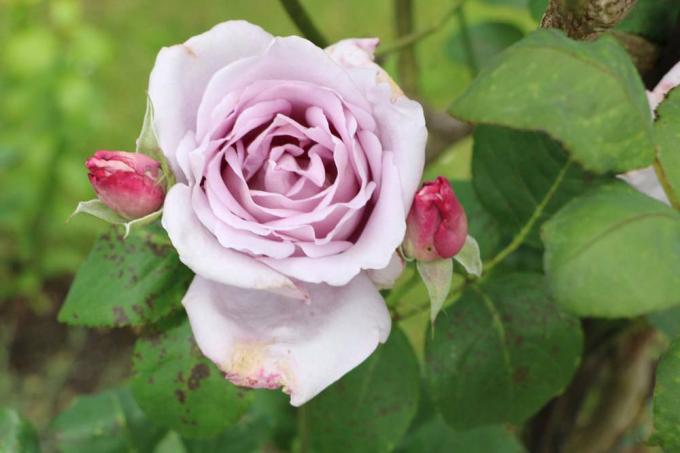
table of contents
- Sheet functionality
- mushrooms
- mildew
- Rose rust
- First aid
- Parasites
- Spider mites
- Thrips
- First aid
When brown spots show up on rose petals, there could be a number of reasons. In many cases it is important to act quickly in order to prevent life-threatening damage. But for this to happen, the cause must be precisely known in order to act correctly. The plant expert describes possible causes and controls in detail.
Sheet functionality
Brown spots on rose petals - what's wrong with my roses?
The rose is one of the most popular types of flowers for gardens and the home. The noble overall picture is often disturbed by brown spots on the rose petals, which can often mean the beginning of the withering away. Therefore, it is essential to act quickly, which only makes sense if the cause is known. Find out below what could be behind the brown spots on rose petals and how you can remedy this.
Sheet functionality
If brown spots have formed on one or more leaves, this is usually a serious sign that the rose is missing something. Usually it is a fungal disease or a pest infestation. In any case, the rose must be treated, as healthy leaves are vital for the rose. Through photosynthesis, the metabolism is stimulated and the energy supply of the plant is secured. The brown spots on rose petals either show a functional disorder that shakes the natural process, or ultimately lead to malfunction because photosynthesis does not take place properly via the damaged leaves can. Sooner or later the rose will die because it cannot survive without intact, healthy leaves.

mushrooms
mildew
Downy mildew (downy mildew)
Although many types of roses are considered to be quite robust, most of the specimens are not resistant to so-called "downy mildew". This is a fungal infection that affects roses from time to time. Above all, cooler temperatures and high humidity promote this type of fungal infection on roses. The fungal disease is mainly observed from spring to autumn. But the downy mildew can also spread in winter when the roses are cool and damp. The fungal spores survive the cold season without major problems.
Recognize
- Leaf spots between yellow-brown and purple-brown
- Spots only on the upper side of the sheet
- Underside of leaf covered with white-gray, slightly sticky mushroom carpet
- increased leaf waste
- in the advanced stage shoots are affected
- Buds remain closed and dry up
- if left untreated, the rose will eventually die

Star soot (Marssonina rosea)
Stubborn and difficult to identify as or an infestation difficult to recognize is the so-called star soot, which, as a fungus, likes to tamper with roses. All types of roses can be affected, although shrub roses are mainly infected by the type of fungus.
It moves into German gardens as early as the end of May, but with optical features it can be used for a long time. It is not uncommon for an infestation to be noticed in the middle of late summer, when the Marssonina rosea has spread across entire rose beds and the roses are now visibly losing strength and vigor. The hose fungus, as it is also known, triggers the black spot disease, which occurs more often in roses than any hobby gardener would like.
Recognize
- large black-brown spots on the upper and lower leaves
- Spots start from the stem and extend to the leaf edges
- often only older leaves near the ground are affected
- then yellow leaves are formed
- Leaves fall off in abundance
- Shoots are attacked, no longer mature and dry out
- reduced frost hardness with possible frost damage

Rose rust
Rose rust (Phragmidium mucronatum)
A very common rose disease is the so-called rose rust, which develops from the fungus Phragmidium mucronatum. He is long-winded because he survives the winter with ease and so for many years at home Roses can plague and damage the garden or balcony if not recognized and treated will. He loves the wet summer and prefers loamy, compacted earth.
Recognize
- initially yellowish and reddish spots on the upper side of the leaf
- rust-brown, small point-like spots on the underside of the leaf
- these turn black-brown in winter (winter storage of the spores)
Ring spot disease
The ring spot disease is one of the typical fungal diseases of roses and is caused by the harmful fungus is caused by the fungus Sphaceloma rosarum. Especially in the rainy summer months it attacks the plants. Due to its striking optical properties, this type of mushroom is easy to identify.
Recognize
- initially red-brownish spots
- later fill with gray dots in the middle
- only distributed individually
- later the spots cluster into one or more large spots
- affected leaves fall off
- the bud growth stops
- Flowers wither quickly
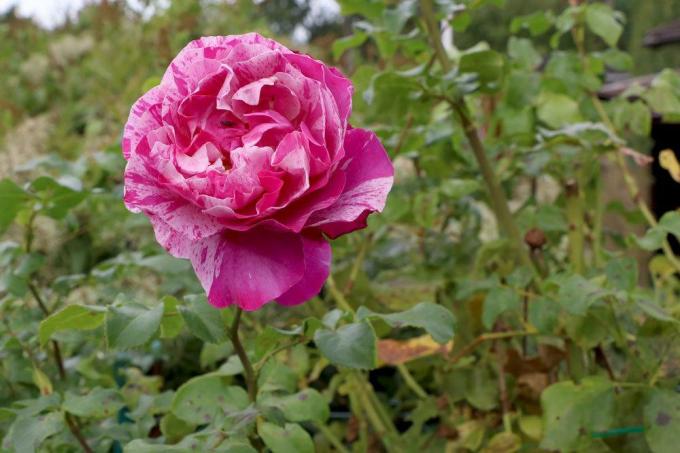
First aid
If possible, contact with roses and other plants affected by fungus should be avoided and kept dry. A generous pruning is usually unavoidable in the case of a larger infestation. But at least all infected rose petals must be cut off immediately and disposed of in household waste or burned.
treatment
Fungi usually penetrate deep into the leaf tissue and the shoots and damage the rose from the inside out. Therefore, quick and, above all, effective control is always recommended in order to avoid bad things. You can choose from a variety of options, from home remedies to organic fungicides and chemical fungicides.
Fungicides
Fungal spores are usually very stubborn because they penetrate deep into the plant's interior and can damage the plant structure from within in a life-threatening manner. If numerous brown spots can already be seen on the leaves, it can be assumed that the fungal infection is well advanced. Here you can usually only get a quick stop against fungus with chemical products. Bayer, for example, offers Baymat rose-mushroom-free and CAMPO offers Ortiva Special mushroom-free. BIO products are usually only suitable if only older leaves are affected and the infection is not yet as widespread.

Home remedies
Practical tests have shown that the onion stock you have prepared yourself is ideal against fungal infections in roses.
The preparation is quite simple:
- Cut 150 grams of onions with the skin into quarters - cut off the ends beforehand
- Pull the onions apart and put them together with the skins and ends in a saucepan
- Boil two liters of water
- Pour boiled water over the onions and cover the saucepan
- Let the brew steep for about 30 minutes
- then sift onions from the broth
- Let the brew cool down
- Dilute the brew with water in a ratio of 1: 5
- fill in a spray bottle
- Spray the soil and rose petals morning and evening for four days
- From the fifth day onwards, spray only once a day
- after about eight days, the fungal infection should have subsided
- As a preventive measure, spray roses every 14 days
Parasites
Spider mites
Spider mites (Tetranychae)
A common clinical picture with brown spots on a rose petal is caused by spider mites, which creep into gardens and houses as annoying parasites. If you look closely, they can be seen with the naked eye. They threaten almost all types of roses, especially between autumn and spring. They feed on the pulp of the leaves and prefer dry and warm places.
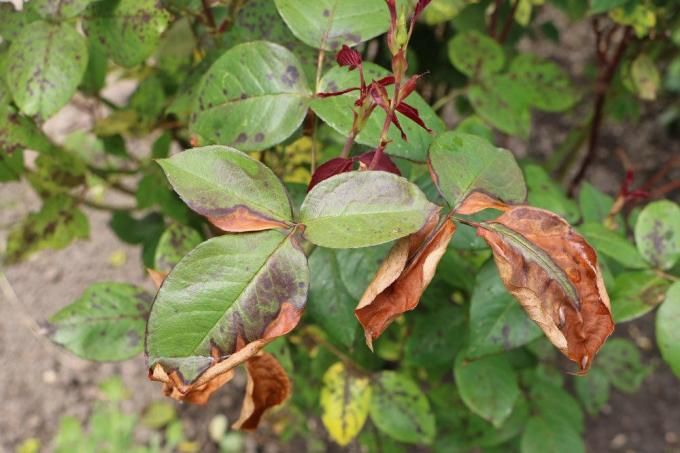
Recognize
- white animals up to one millimeter in size
- Brown spots usually form on the underside of the leaf around the sucking points
- white, sticky webs form over the entire leaf
- after the brown spots, the rose petals usually turn yellow
- after that it falls off
- the spider mites evade except for the shoots
- form their webs there
- wooden parts now die off and the rose dies
Rose wasp (Cladius difformis)
The cladius difformis is a parasite. Once the rose is attacked by this pest, it spreads rapidly and leaves fall off within a very short time. Typical identifying features are the signs listed below.
- brown spots on the leaf surfaces
- Leaf damage with central holes or marginal bays
Thrips
Thrips (Thysanoptera)
Thrips are particularly attracted to the plants in winter when the heated air is dry, but roses are usually less affected. But even in midsummer they pull their food out of the leafy green and leave behind damage that, without any control, causes the leaves and ultimately the roses to die off.
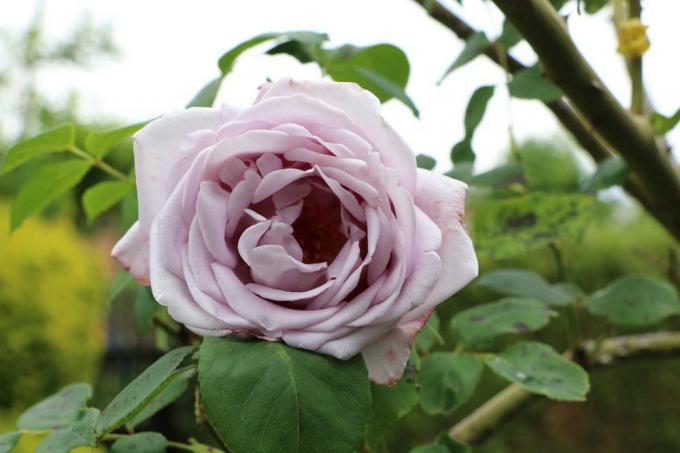
Recognize
- one to three millimeters long, multi-legged, elongated animals
- dark brown to brown-black in color
- Larvae colored yellowish to white-money
- are mostly on the underside of the leaf
- leave yellow and brown spots
- the brown spots often have a small hole in the middle
- dark brown to black spots on the leaf can be seen through faeces
First aid
In order to avoid the spread of parasites in the house or in the plant bed, it is essential to isolate the affected roses. Planting out bed roses is recommended if other roses or other plants have not yet shown any typical symptoms, but are close to the affected specimen.
treatment
Parasites are usually quite easy to get to grips with on roses once they have been recognized as such. The dangerous thing about them is that they can spread extremely far if left unchecked. This means that the worst case does not occur when your rose dies, but when the rose pests have spread over your entire flower landscape.

insecticides
Poisonous insecticides are offered specifically for parasites on roses. They mainly contain substances that act on the central nervous system and thus trigger the death of the parasites. In most cases, they are not very environmentally friendly and your own health often does not react positively to the use of chemical insecticides. For example, these can cause skin irritation or worsen asthma. It is therefore only advisable to use chemical insecticides if large rose beds are infested with pests and rapid control is required.
For smaller infestation sizes, the use of biodegradable products is recommended, which "work" just as effectively but possibly with a somewhat later onset of action. The manufacturers Neuendorff and BAYER have such products in their range, for example based on neem oil.
TIP: You can also use neem oil to prevent spider mites. From May, simply spray on the roses every 14 days when these shoots have reached at least five centimeters.
Home remedies
A few home remedies that you can easily prepare into sprayable solutions yourself are somewhat slower to work, but therefore no less effective. Numerous home remedy recipes for pests can be found on the Internet. However, one of the most effective is the garlic brew against the rose pests mentioned here.
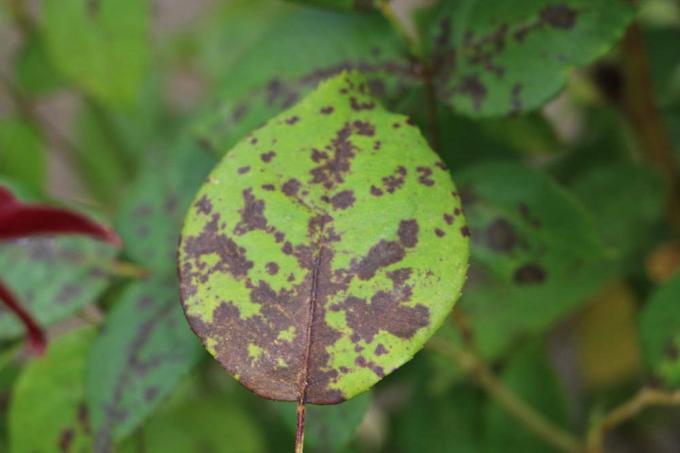
- Provide one liter of water with a pH below 6.0
- crush three cloves of garlic
- Pour garlic mixture into the water and stir
- Let the brew rest at room temperature for 24 hours
- stir vigorously again
- Sieve the garlic from the water
- Pour the brew into a spray bottle
- Spray infested roses generously on a daily basis
- After about a week, the pests such as spider mites and the like should be gone
TIP: A clove of garlic stuck in the ground near the rose root provides and keeps almost all parasites at a distance.
Conclusion
Brown spots on the leaves of your roses should not be taken lightly, as they can be life-threatening not only for your roses. If you can at least roughly distinguish whether it is a fungal disease or a pest, you can quickly help roses with the control measures mentioned here and they will bloom again in their usual elegance permit.



